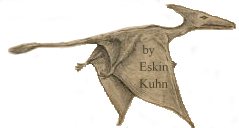With the right winds, butterflies can sometimes get across the Atlantic Ocean, at least from North America to Ireland. So could a kongamato get across the Atlantic from Africa? I like to think of it from another perspective: Could a species of large pterosaur be prevented from crossing the Atlantic if countless of the flying creatures flew off the west coast of Africa for countless centuries? What could prevent their eventual migration?
One species of crane flies over the Himalayan Mountains regularly, sometimes at an altitude of 30,000 feet. Large nocturnal pterosaurs, under the right wind conditions, could cross the Atlantic, from Africa. As more sighting reports come in from Africa and North America, we need to look at the possibility that some of the flying creatures on different sides of the Atlantic may be closely related or even the same species.
. . . I had been in Cuba for perhaps four months and the SeaBees were engaged in constructing new barracks for us . . . It was a beautiful, clear summer day . . . I was looking in the direction of the ocean . . . I am an artist with sharp eye for detail and was determined to drink in the visage before me for future recording on paper. I saw two pterosaurs flying together at low altitude, perhaps 100 feet, very close in range from where I was standing, so that I had a perfectly clear view . . . The vertebrae of their backs was noticeable, mostly between the shoulders. I would estimate their wingspan to be roughly ten feet.
Pterosaur Extinction Indoctrination
Standard Western paleontology is based upon assumptions about extinction. When a dinosaur fossil or a pterosaur fossil is discovered in a stratum, that layer of rock may be subject to reevaluation: given a different date based upon the popular ideas about when that species lived and when it became extinct.
But what if a species of pterosaur never became extinct? What would that do to paleontology, in particular with dating a stratum by the existence of a fossil of that species being found in that stratum?
Gitmo Pterosaur
The sketch shown above was drawn by the U. S. Marine Eskin Kuhn, who witnessed two of the long-tailed featherless flying creatures (obvious pterosaurs) flying at “close range” at the Guantanamo Bay military installation in Cuba, in 1971.




One Reply to “Kongamato Crossing the Atlantic?”
Comments are closed.